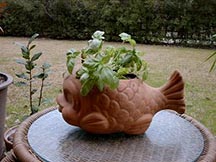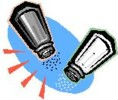Make the most of culinary herbs and spices.
Other articles you might enjoy:
1. An Herb Gardener's Diary--Part Five
2. Combination Plantings Equal Culinary Pots
An Herb Gardener's Diary - Part
Two
by Sandra Bowens
Here's one that's full of our favorite recipes because we wrote the book! It is also full of information, helpful hints and ideas for using herbs and spices in your kitchen.
Gardening is like most of life's pursuits. It can be rewarding as well as frustrating, exciting as well as disappointing. The way I see it is that if you are learning along the way, each step is valuable.
Learning from mistakes
By accident I have learned that dirt does matter. For container planting you want to use potting soil designed for that purpose. I have gone through bags and bags of the stuff as I put together my garden of pots. Somewhere in there I must have bought a bag of "garden soil" instead.
Garden soil is what you mix into your planting beds along with a natural fertilizer like compost or other organic matter. It does not work for container plants. I never really understood why but I can now attest to the truth of that statement.
I had planted lettuce seeds in a nice window box container way back in February or March. The lettuce never did take off although it had sprouted and shown promise. Finally, I decided to abandon that project and plant some flowers in the pot instead. As I was changing the soil I noticed it was much different that what I usually used. The lightbulb came on and I started looking at other plants that were struggling.
They were all in this same soil. The telltale sign was the lack of the little white flecks of what I think is vermiculite.
The herbs that I had previously thought might have been damaged in dividing to share with my friends were in this soil. At least this explains why my dill, parsley, marjoram and sage have been exceedingly slow in growing. Now I am faced with trying to change them into new potting soil or just start new seeds. Tune in next month…
Propagation is another project I am still in the early stages of learning about. This is making new plants from existing ones. We have probably all placed a cutting into a glass of water to root. This works well for some plants but others require different methods.
Chives, for example, grow in clumps that can, and should be, split up every three years. You simply break the clumps into sections and replant them. My plant is still too young to try this.
The "rooting" method is one I find amazing. A friend of mine pinched a bit of mint from her gorgeous plant, dipped the cut end into a white powder called 'rooting hormone' and told me just to stick it in a pot of dirt. Doubtful, I did as I was told. It has been just over a week and new shoots are springing from where the original leaves were growing.
Annuals and Perennials
I did not realize until recently that herbs fall into the same classifications as flowers and other garden plants. Annuals are plants that grow from seed, they flower, set seed and die within a single season. Perennials will come back year after year.
To avoid disappointment, it's good to know which herbs are annuals and which are perennials. At one lecture I attended a man expressed concern that his basil plants would grow very well for a while but always died on him. The Master Gardener patiently explained that basil is an annual, this is its nature.
These classifications also clarified something else for me. Annuals are much easier to grow from seed than perennials. Annuals include dill, parsley, basil, fennel, chervil, cilantro and arugula.
Perennials such as bay, chives, mint, rosemary and thyme can be grown from seed but we may find it much easier, and be able to harvest them much more quickly, if we buy established plants.
Pinching
Although they are beautiful plants, the point of growing herbs is so that you can use them in the kitchen. It is so much fun to be in the middle of a recipe and dash out to the garden with your scissors for one of the ingredients. Last night I had several dishes that called for basil so I just brought the whole pot into the kitchen.
This nipping away for recipes has a name--pinching--and it is important to the plant. It will get bushier and remain healthy as you enjoy the benefit of fresh flavors. Just don't take more than one third of the foliage at a time and try to pinch in a way that keeps the plant looking good too.
For the most part, you should pinch flowers as well. I am not exactly clear on this point and cannot seem to find the answer in any of my books. I think that pinching flowers will prevent the plant from putting wasted energy into seed development for perennials. It may actually extend the life of annuals if you pinch the flowers before they form. I'm still working on these fine points, bear with me.
The herbal flowers that I have in my pots are lovely. The chives have sent out purple puffs that taste strongly of onion. They are a wonderful addition to salads, however, where the combination with other ingredients seems to tone them down. I let the ones we don't eat go until they begin to wilt, then I trim them back.
The arugula, a cool season annual, sent up a gorgeous little white flower just before it died. My basil also keeps trying to sprout flowers; perhaps its life expectancy is about up. They are very pretty little white flowers, too, so I let a few go ahead and bloom.
Herbal Veggies
If you are going to get into herb gardening, I urge you to consider planting a few vegetables as well. Consider onions, garlic, and any of the wide range of spicy peppers out there as possibilities to enhance your herbal cooking. And don't forget the tomatoes!
I planted a pot of onions from an 'onion set' a few months ago. Unfortunately I planted them in aforementioned garden soil but they are growing slowly. The beauty of onions is that before they mature, they are green onions. You can plant the bulbs from the onion set very close together, harvest the green onions as they grow thereby making room for the bigger ones later. Ingenious I think!
The jalapeno plants I bought at the local nursery have been fun to watch. Peppers are attractive plants that don't get too large. Mine are just full of mini-jalapenos and the ones we have eaten are hot, hot, hot.
Tips
Lucky for me, there are no real disasters in container gardening. Minor setbacks just make it interesting. Here are a few hints that I can pass along:
1. If you are unsure about some aspect of gardening, ask plenty of questions at your local nursery or plant place. I have found the folks at the local Home Depot garden center helpful and knowledgeable for the most part.
2. Be sure to find out if your plant is an annual or a perennial so that you know what to expect.
3. Think about the herbs and vegetables you like to eat the most and start by growing those.
4. Try this garden-inspired salsa next time you want to dip some chips or garnish a piece of broiled fish: Combine a chopped avocado with a sliced green onion, one jalapeno and half a tomato. Add the juice of a lemon plus some salt and pepper. It brought my garden to the table.
It's been so much fun tending to my herb plants. Once again, I encourage you to try your thumb at planting. To share your own experiences with other aPinchof.com website readers, write to us.

Learn herb gardening from the ground up, literally, with the help of a knowledgeable teacher and gardener.
Straight from the experts with a bonus chapter of stunning photos and information about the National Herb Garden in Washington, D.C.
Rosalind Creasy knows all about using food plants to round out your yard. She pioneered the idea 25 years ago. This updated edition includes 300 inspiring photographs.
Plant it, grow it, eat it: this book shows you how! An old favorite recently updated for the way we cook today.







